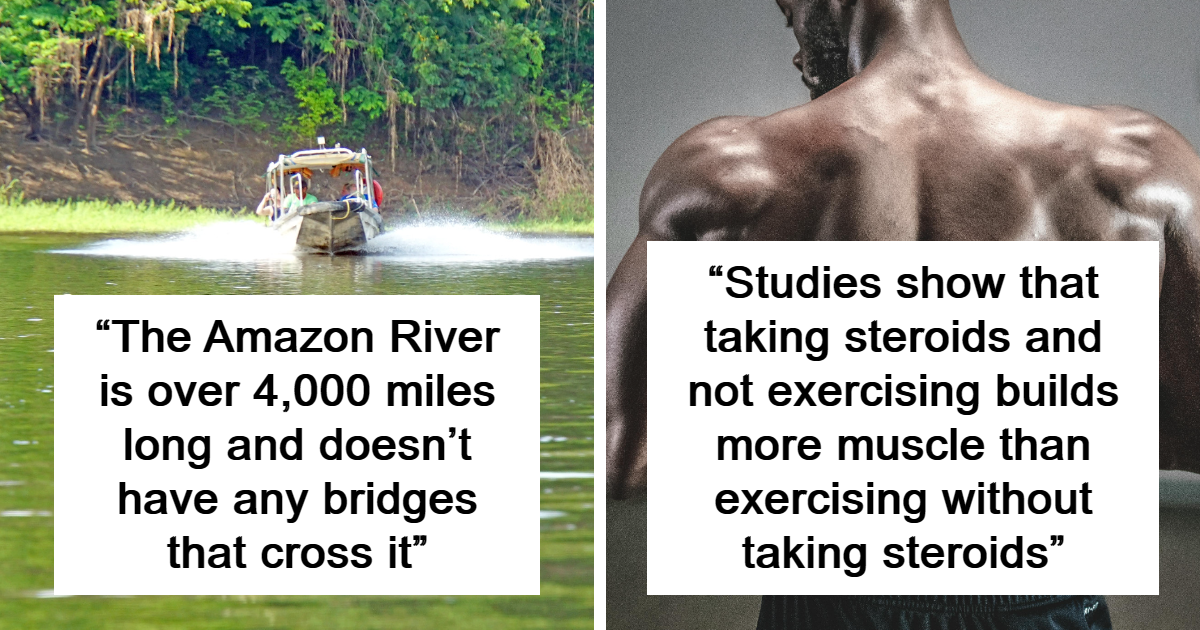28 Interesting Facts To Intrigue The Ever-Curious
Article created by: Ilona Baliūnaitė
It’s clear that one simply can’t know everything there is to know about, but that never stopped a curious mind from learning. Luckily, in the age of the internet, it has never been easier; with just a few clicks you can reach information about anything and everything that interests you.
You can also start a discussion with fellow netizens in a matter of a couple of clicks, too, and that’s exactly what the redditor u/Jdavies44 did. They were curious to learn about interesting facts few people knew about so they asked fellow redditors to share them, and they discussed some rather fascinating things. If you’re curious to read about them, too, wait no longer and scroll down to find their answers on the list below.
Below you will also find our interview with a behavioral expert, author of Cracking the Curiosity Code, Dr. Diane Hamiltonwho was kind enough to answer a few of Bored Panda’s questions about how fun facts, curiosity, and learning intertwine.
 In mid-2000s Kagoshima, Japan, an alarming rise in power blackouts was traced back to crows who were building their nests on top of electric poles. The power company formed a “Crow Patrol” in order to seek and destroy the crows’ nests. The crows responsed by building thousands of dummy nests as decoys.
In mid-2000s Kagoshima, Japan, an alarming rise in power blackouts was traced back to crows who were building their nests on top of electric poles. The power company formed a “Crow Patrol” in order to seek and destroy the crows’ nests. The crows responsed by building thousands of dummy nests as decoys.
The war is ongoing.
 The weirdest animal in the world is the jellyfish called the Portuguese Man ‘o War (also called a bluebottle in Australia).
The weirdest animal in the world is the jellyfish called the Portuguese Man ‘o War (also called a bluebottle in Australia).
It gives birth via a process called “budding”, where a new animal just sort of pops off a random place on the jelly. But it doesn’t give birth to whole other jellyfish. It gives birth to many different types of animal-like creatures called “zooids”. They live on the bottom of the jelly, live independently from each other, but can’t survive without the others.
For instance, there’s a zooid that can digest fish, but can’t catch them. There’s a tentacle zooid that can catch fish, but can’t digest them. There are also several other zooids like that. Scientists have been scratching their heads about how to classify this creature, and are calling it a colony rather than an animal.
And that leads to an interesting question. What is the organism? Is it the zooid, because it moves around independently, but can’t really survive very long on its own? Or is it the whole jellyfish, in which case the zooids are a bit like organs, except for the fact that they might go for a walk occasionally?
And if you say that the whole jellyfish is the organism, maybe bees aren’t an organism either, but a beehive is?
That’s the problem with classification systems. As soon as you make one, along comes some weird example that makes you have to start again.
 Lake Superior. on that lake is an island called Isle Royale. on that island is a lake. on that lake is an island. on that island is a pond, and on that pond is boulder. that boulder is the largest island on the largest pond on the largest island on the largest lake on the largest island on the largest lake in the world (by surface area).
Lake Superior. on that lake is an island called Isle Royale. on that island is a lake. on that lake is an island. on that island is a pond, and on that pond is boulder. that boulder is the largest island on the largest pond on the largest island on the largest lake on the largest island on the largest lake in the world (by surface area).
 Switzerland, the country of neutrality, has unintentionally invaded its neighbor Liechtenstein 3-5 times…1968-2007.
Switzerland, the country of neutrality, has unintentionally invaded its neighbor Liechtenstein 3-5 times…1968-2007.
3/4 times Liechtenstein didn’t know of it until Switzerland apologized.
The 1/4 was that one time Switzerland fired a missile and caused a forest fire, reparations were paid.
After one incident, the Liechtensteiners reportedly offered drinks to the Swiss soldiers.
A Liechtenstein spokesman said, “It’s not like they invaded with attack helicopters”.
 Shirley Temple led an extremely successful life as a diplomat after her childhood acting career. She was present in Czechoslovakia when the Soviet’s cracked down on them (as in, she seen people killed). Later after the fall of the USSR, she was the head of establishing diplomatic relations between the US and Czechoslovakia.
Shirley Temple led an extremely successful life as a diplomat after her childhood acting career. She was present in Czechoslovakia when the Soviet’s cracked down on them (as in, she seen people killed). Later after the fall of the USSR, she was the head of establishing diplomatic relations between the US and Czechoslovakia.
 When you put a bumper sticker or decal on, spray a couple sprays of diluted soapy water or simple green on the surface of the car first, then put the sticker down…. And you can slide it around until it’s even and centered. Use a credit card to squeegee the moisture out from underneath, pat dry, and leave it alone. It’ll adhere as it dries.
When you put a bumper sticker or decal on, spray a couple sprays of diluted soapy water or simple green on the surface of the car first, then put the sticker down…. And you can slide it around until it’s even and centered. Use a credit card to squeegee the moisture out from underneath, pat dry, and leave it alone. It’ll adhere as it dries.
No more crooked stickers.
 Solar eclipses are a completely random quirk of arbitrary factors.
Solar eclipses are a completely random quirk of arbitrary factors.
The sun is roughly 400x bigger than the moon. The sun is also roughly 400x further away from earth than the moon.
Nothing created or enforces that ratio. It’s just a random happenstance that from our view, on the surface of this planet, the sun and moon seem roughly the same size, and can perfectly overlap.
 A compressed spring weighs more than when the same spring is at rest. The stored potential energy of the compressed spring makes it heavier.
A compressed spring weighs more than when the same spring is at rest. The stored potential energy of the compressed spring makes it heavier.
Really puts e = mc^2 into perspective.
 Nike has warranties on their shoes. If yours remains in the tread life and within the warranty date, you just make a claim and they’ll give you a voucher for new shoes and paid postage to send the old ones back.
Nike has warranties on their shoes. If yours remains in the tread life and within the warranty date, you just make a claim and they’ll give you a voucher for new shoes and paid postage to send the old ones back.
Target will also take any Cat and Jack clothes back for an exchange as your kids grow.
Brake pads only need to be bought once for the life of a car. They are then warranty exchanged as you wear them out.
Clearly, I’m a dad.
 Most of the time, the closest planet to Earth is Mercury. Actually, most of the time Mercury is the closest planet to all of the other planets, too. Even Pluto.
Most of the time, the closest planet to Earth is Mercury. Actually, most of the time Mercury is the closest planet to all of the other planets, too. Even Pluto.
If you don’t believe it, try a quick experiment. Take four cookies (or other small objects) and line them up on a table in front of you, perpendicular to your body. The closest cookie represents Earth. The next cookie is Venus, then Mercury, then the farthest cookie is the Sun. Obviously, Venus is closest to Earth in this configuration.
Now move Venus and Mercury in their “orbits” 90 degrees to the right (or left, it doesn’t matter) of the Sun. Measure the distance from Earth to Mercury and Venus. Mercury is now closest to Earth.
Move Venus and Mercury another 90 degrees and Mercury is obviously closer, even without measuring, but measure it if you want to.
Move Venus and Mercury another 90 degrees and you’ll have the mirror image of the first 90 degrees configuration. Measure it if you want to. Mercury is still closest to Earth.
You have to move Venus and Mercury closer to the Earth before you get to a point where they are the same distance from Earth. It works like this for all the planets.
Venus and Mercury and don’t revolve together like this in real life. They revolve at different speeds. But over thousands or millions of years, it all averages out.
 Studies show that taking steroids and not exercising builds more muscle than exercising without taking steroids. The percentage of obese people who get to and maintain a healthy weight is statistically lower than the percentage of people who survive a gunshot to the head.
Studies show that taking steroids and not exercising builds more muscle than exercising without taking steroids. The percentage of obese people who get to and maintain a healthy weight is statistically lower than the percentage of people who survive a gunshot to the head.






